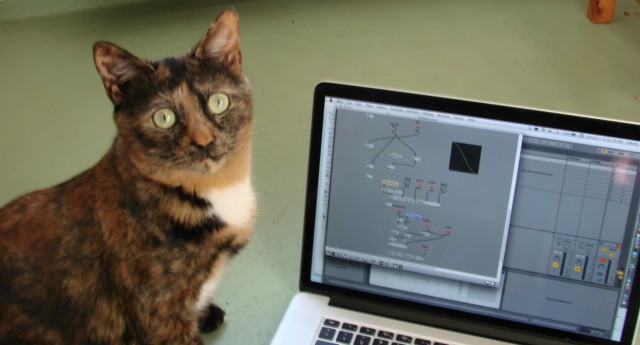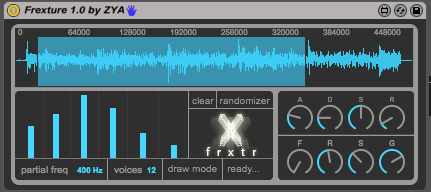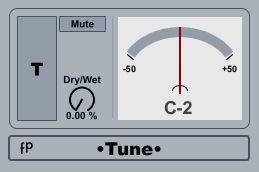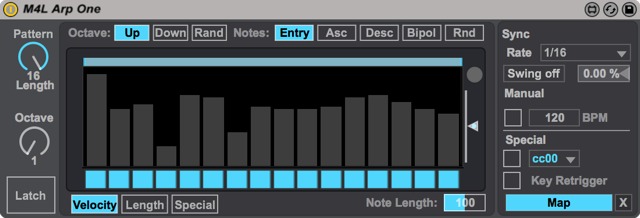It’s called Max for Cats. But you don’t play it with a laser pointer and your feline friend. (Note to self: project idea.) The latest from sonic mastermind Christian Kleine, Ensemble and DiGiTAL are in fact terrifically-rich string and digital synthesizers, respectively, for Ableton Live and Max for Live.
Getting to know their creator is just important as getting to know those tools, though. Christian Kleine is a uniquely fusion of musician and engineer. Hailing from Lindau but making a name for himself in mid-90s Berlin, his musical career itself is already newsworthy, as a soloist and as half of Herrmann & Kleine. But just as Berlin became an epicenter for music technology as well as music, he went on to a career in sound design and sonic engineering, now honing his enviable Max for Live skills at Ableton.
So, of course, CDM readers need to know not only what new devices Christian has made, but a little bit about how he approaches creation as toolmaker and musician. And we need exclusive pictures of his studio, which he doesn’t normally allow. (He said he gets embarrassed. Of… being awesome? Not sure.)
And, of course, we need to meet his cat.
First, those new Devices.
Ensemble is a retro-styled string synth (think Arp Solina SE-IV), with aftertouch control and pulse-width modulation support. Things start to get interesting around the formant filter, with ten vowels (clickable – eee!) and morphing. And the nice Chorus and Phaser are also available standalone. (Doubly welcome, as some of those built-in Ableton Devices are beginning to sound a bit recognizable!)
DiGiTAL is a full-blown polyphonic synth, one that could easily stand on a level with something like Ableton’s Operator; it feels like it could be the synth in Live 10. You get a hybrid approach – additive, wavetable, frequency modulation and subtractive synthesis are all on offer – but brought together graphically. Everything centers on a view of the wavetable and harmonic content. Paired with an Oberheim 2-Voice-inspired sequencer, modulation matrix, EQ and chorus built-in, and lots of extras, this is a really serious synth.
Each Device is 29€ / US$39, on sale for 20€ / $27, on the Ableton store.
CDM: Tell us a bit about your relationship with Max for Live. How did you get into using Max in the first place?
Christian: In the late 90s, I tried out all available music software. I finally had a Mac after using the Atari [ST] with Steinberg’s “TWELVE” and Digidesign TurboSynth for some time.
Among these were CSound, SuperCollider and [Native Instruments’] Generator (Reaktor fore-runner).
And Max (soon: Max/MSP). I did stick with Max; I found it most intriguing. Later I made many Pluggos [the former plug-in format for Max/MSP], and at some point we ([Ableton co-founders] Robert [Henke], Gerhard [Behles], some others and me) discussed the possibility to integrate Max into Live and, of course, I was delighted. I did a bit of device prototyping for Max for Live then.
How did you assemble these two new Max for Cats creations? What inspired them?
Since I bought my first synth (the [Clavia] Nord Lead 1) in 1995, I was hooked on synths because of their — in my mind — mystical sound abilities, after having being a guitarist/bass player. I refined my passion over the years and since I could somehow make my sonic ideas audible via Max, it is either hardware, synthesis concepts, or pure fun trying out new things that inspires my stuff.
The main goal for me is still that it must be easy to use, fun, musical ,and have a certain depth to it. I have no problem with imperfections or weird things – these often can inspire whole genres!
Any tips for using these Devices?
Get familiar with the character and strength of an instrument in order to remember when and where to use it best.
We luckily live in times where almost everybody with a computer has access to nearly any (synthesis-) technology, but learning every aspect of synthesis is often tedious. (I remember programming the additive [Kawaii] K5 is not really fun while it is to use, for example, Dark Synth (or my own Digital, I hope!).
Obviously, you’ve got some mastery of Max for Live. But what about those just starting out – any advice on how to tackle the depth of the software?
I witnessed that most people who fail to learn Max (for Live) have no idea what they want to achieve with it – so I would say that having a goal would be the first step.
Do you want to achieve glitch sounds because you like Autechre, etc.? Learn how to create a random delay line!
Do you want to create create visuals which move according to the pan position of stereo sine waves? You’ll certainly find a tutorial which brings you closer to this achievement!
Also, don’t be afraid to ask – after all, there is this wonderful global community aspect of Max (and similar languages).
Last but not least, the nice thing about Max is that you can look at the handwriting of each programmer and see how they tackled a specific problem.
That makes sense. And we should note that you can have a look at the inside of Max for Live devices – even these. I certainly know I don’t learn how to do these things without a project in mind, a goal to struggle against.
So, speaking of looking at other Max creations, got any favorites from the community?
There are so many nowadays! Some faves: (would be different tomorrow!)
Of course, the wonderful ML-185:
ML-185 Stage Controlled Sequencer
And the simple but great tuner:
fp.Tune
[Ed.: note that this uses fiddle~, the landmark pitch detection object in both Max and Pd by their original creator, Miller Puckette – worth checking it out.]
And and and 🙂 of course there are many really good ones for 5-20 $.
Thanks, Christian! We’ll look forward to the Max for Cats instruments – and see the MIDI-based Devices below, too.









